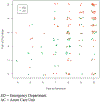Opioid doses and acute care utilization outcomes for adults with sickle cell disease: ED versus acute care unit
- PMID: 28802541
- PMCID: PMC7083150
- DOI: 10.1016/j.ajem.2017.07.037
Opioid doses and acute care utilization outcomes for adults with sickle cell disease: ED versus acute care unit
Abstract
Background: Acute care units (ACUs) with focused sickle cell disease (SCD) care have been shown to effectively address pain and limit hospitalizations compared to emergency departments (ED), the reason for differences in admission rates is understudied. Our aim was compare effects of usual care for adult SCD pain in ACU and ED on opioid doses and discharge pain ratings, hospital admission rates and lengths of stay.
Methods: In a retrospective, comparative cohort, single academic tertiary center study, 148 adults with sickle cell pain received care in the ED, ACU or both. From the medical records we documented opioid doses, unit discharge pain ratings, hospital admission rates, and lengths of stay.
Findings: Pain on admission to the ED averaged 8.7±1.5 and to the ACU averaged 8.0±1.6. The average pain on discharge from the ED was 6.4±3.0 and for the ACU was 4.5±2.5. 70% of the 144 ED visits resulted in hospital admissions as compared to 37% of the 73 ACU visits. Admissions from the ED or ACU had similar inpatient lengths of stay. Significant differences between ED and ACU in first opioid dose and hourly opioid dose were noted.
Conclusions: Applying guidelines for higher dosing of opioids for acute painful episodes in adults with SCD in ACU was associated with improved pain outcomes and decreased hospitalizations, compared to ED. Adoption of this approach for SCD pain in ED may result in improved outcomes, including a decrease in hospital admissions.
Keywords: Acute care unit; Emergency department; Hospital admission; Opioid; Pain; Sickle cell disease.
Published by Elsevier Inc.
Conflict of interest statement
The authors declare no conflicts of interest.
Figures
Similar articles
-
The association between timely opioid administration and hospitalization in children with sickle cell disease presenting to the emergency department in acute pain.Pediatr Blood Cancer. 2020 Sep;67(9):e28268. doi: 10.1002/pbc.28268. Epub 2020 Jul 2. Pediatr Blood Cancer. 2020. PMID: 32614150 Free PMC article.
-
Opioid prescription practices at discharge and 30-day returns in children with sickle cell disease and pain.Pediatr Blood Cancer. 2017 May;64(5). doi: 10.1002/pbc.26319. Epub 2016 Nov 1. Pediatr Blood Cancer. 2017. PMID: 27800652
-
Timing of opioid administration as a quality indicator for pain crises in sickle cell disease.Pediatrics. 2015 Mar;135(3):475-82. doi: 10.1542/peds.2014-2874. Epub 2015 Feb 9. Pediatrics. 2015. PMID: 25667245
-
Management of the acute painful crisis in sickle cell disease- a re-evaluation of the use of opioids in adult patients.Br J Haematol. 2014 Jul;166(2):157-64. doi: 10.1111/bjh.12879. Epub 2014 Apr 18. Br J Haematol. 2014. PMID: 24750050 Review.
-
Management of acute pain in adults with sickle cell disease: the experience of the Clinical Hematology Department of the University of Dakar.Turk J Med Sci. 2024 Jul 17;54(5):1185-1189. doi: 10.55730/1300-0144.5897. eCollection 2024. Turk J Med Sci. 2024. PMID: 39473749 Free PMC article. Review.
Cited by
-
Impact of early analgesia on hospitalization outcomes for sickle cell pain crisis.Pediatr Blood Cancer. 2018 Dec;65(12):e27420. doi: 10.1002/pbc.27420. Epub 2018 Aug 27. Pediatr Blood Cancer. 2018. PMID: 30151977 Free PMC article.
-
Patient-Reported Outcomes and Economic Burden of Adults with Sickle Cell Disease in the United States: A Systematic Review.Int J Gen Med. 2020 Jul 7;13:361-377. doi: 10.2147/IJGM.S257340. eCollection 2020. Int J Gen Med. 2020. PMID: 32753936 Free PMC article.
-
Opioid Prescription Filling Trends Among Children with Sickle Cell Disease After the Release of State-Issued Guidelines on Pain Management.Pain Med. 2020 Oct 1;21(10):2583-2592. doi: 10.1093/pm/pnaa002. Pain Med. 2020. PMID: 32142138 Free PMC article.
-
Implementation of Individualized Pain Care Plans Decreases Length of Stay and Hospital Admission Rates for High Utilizing Adults with Sickle Cell Disease.Pain Med. 2021 Aug 6;22(8):1743-1752. doi: 10.1093/pm/pnab092. Pain Med. 2021. PMID: 33690845 Free PMC article.
-
Predictive Factors for 30-Day Readmission and Increased Healthcare Utilization in Sickle Cell Disease Patients: A Single-Center Comparative Retrospective Study.Int J Gen Med. 2024 May 10;17:2065-2075. doi: 10.2147/IJGM.S461778. eCollection 2024. Int J Gen Med. 2024. PMID: 38746949 Free PMC article.
References
-
- Shankar SM, Arbogast PG, Mitchel E, Cooper WO, Wang WC, Griffin MR. Medical care utilization and mortality in sickle cell disease: a population-based study. Am J Hematol 2005;80:262–70. - PubMed
-
- Raphael JL, Dietrich CL, Whitmire D, Mahoney DH, Mueller BU, Giardino AP. Healthcare utilization and expenditures for low income children with sickle cell disease. Pediatr Blood Cancer 2009;52:263–7. - PubMed
-
- Benjamin LJ, Swinson GI, Nagel RL Sickle Cell Anemia Day Hospital: An approach for the management of uncomplicated painful crisis. Blood 2000;95:1130–6. - PubMed
-
- Ballas SK. Sickle cell pain. 1 edition ed. Seattle: IASP Press; 1998.
Publication types
MeSH terms
Substances
Grants and funding
LinkOut - more resources
Full Text Sources
Other Literature Sources
Medical


